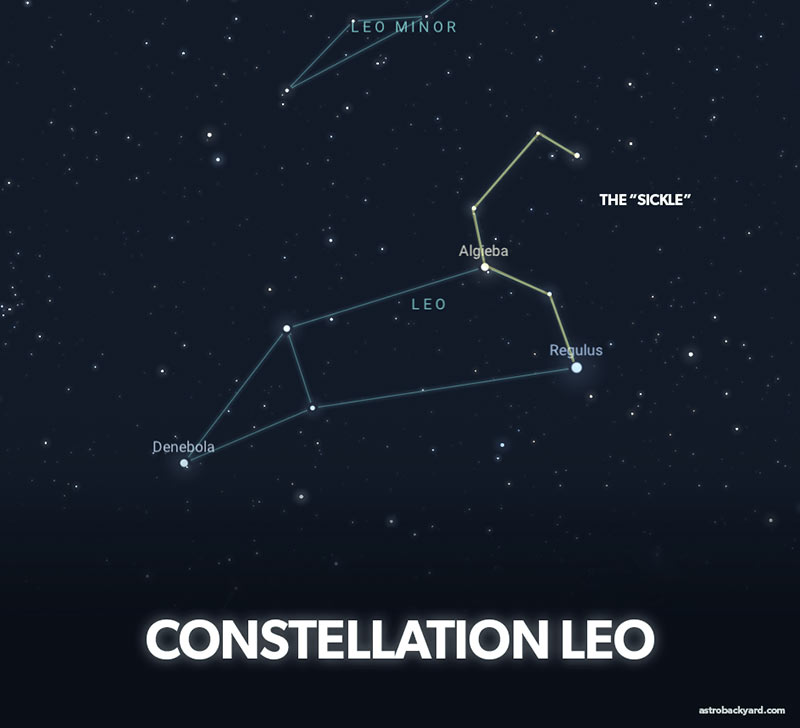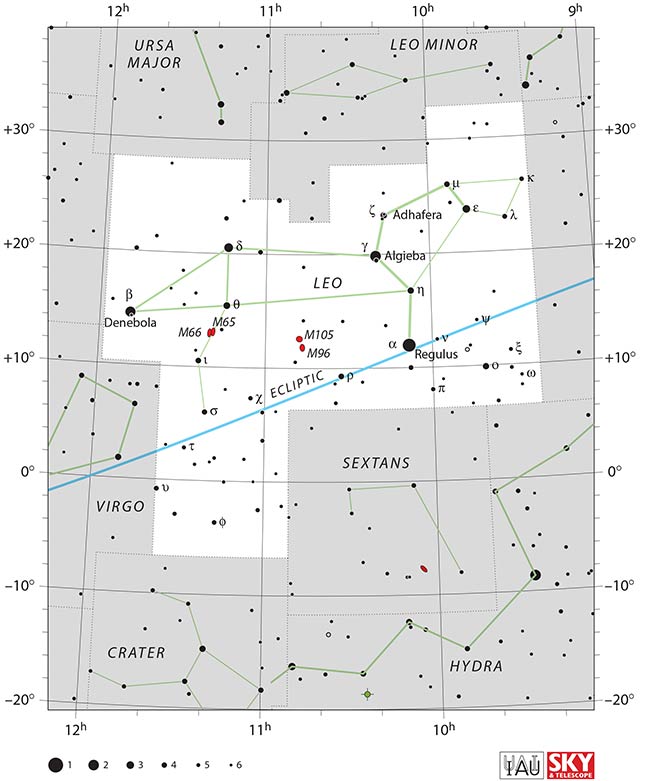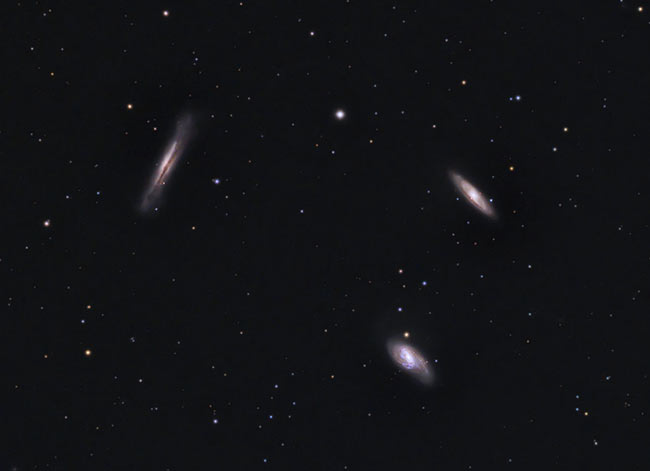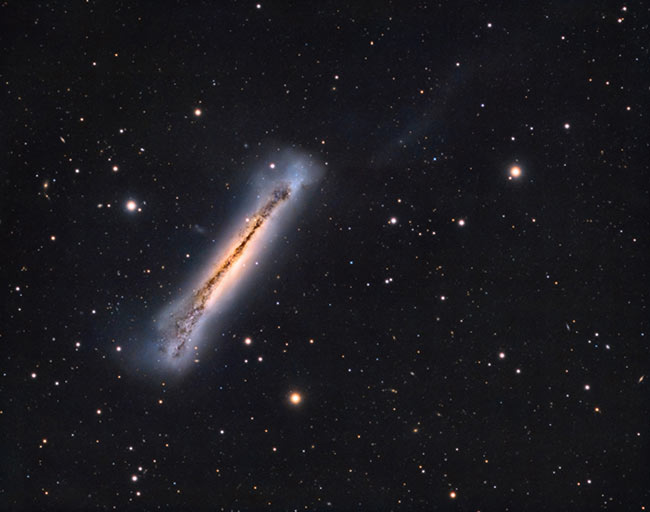The Leo Constellation
The Leo constellation is one of the earliest recognized constellations in the night sky. Its shape, which resembles a crouching lion, and bright stars also make it one of the most highly and easily recognized of the 88 modern constellations.
The six bright stars in the lion’s mane and shoulders form ‘the sickle’ asterism, which resembles a backward question mark. Regulus, which is located at the bottom of the ‘question mark’ is the 22nd brightest star in the sky and is also part of the spring triangle asterism.
The shape of the Leo Constellation. Image created using Stellarium Web.
The Leo constellation is associated with an annual meteor shower in the night sky. The Leonids meteor shower peaks between November 17-18 and again in January between 1-7.
Leo is also a member of the zodiac family constellations.
Constellation Details
- Symbolism: The Lion
- Brightest Star: Regulus
- Number of stars (total): Nine
- Size: 947 sq. deg. (12th largest)
- Right Ascension: 11h
- Declination: +15°
Constellation Stars
The nine stars that make up the Leo constellation are:
- Ras Elased Australis (Epsilon Leonis)
- Ras Elased Borealis (Mu Leonis)
- Adhafera (Zeta Leonis)
- Algieba (Gamma Leonis)
- Eta Leonis (Al Jabbah)
- Regulus (Alpha Leonis)
- Chertan (Theta Leonis)
- Denebola (Beta Leonis)
- Zosma (Delta Leonis)
Leo’s Sickle, which includes the stars that form the head and shoulders of the Lion, includes six stars and was named after a harvesting tool. The six stars included are Epsilon, Mu, Zeta, Gamma, Eta, and Alpha Leonis.
Brightest Stars in the Leo Constellation
The brightest star in the Leo constellation is Regulus with an apparent magnitude of 1.35 and is located at the base of ‘the sickle’ asterism. It is also the only first-magnitude star to sit almost directly on the ecliptic.
Though Regulus appears as a singular blue-white star, it is actually a multiple four-star system with two pairs of stars. Regulus A is a spectroscopic binary star (blue-white main-sequence star) and its companion star is believed to be a white dwarf. Regulus B, and its companion star, Regulus C are dimmer main sequence stars that are bound together by gravity.
The second brightest star is Denebola, an A-type main-sequence star-forming the tail of the lion.
Leo Constellation Star Map Sky and Telescope/IAU.
When can you see Leo?
The best time to see the constellation Leo in the North Hemisphere is in the spring from late March to May. During this time it is visible as soon as it’s dark and stays out until early morning.
In April, it will reach the highest point in the sky around 10 p.m. By July, Leo will start to sink below the western horizon.
In the Southern Hemisphere, it can be seen from summer and autumn.
How to Find the Leo Constellation
You can use the backward question mark, or ‘the sickle’ pattern to find Leo. The bright blue-white star Regulus will be located at the bottom of the sickle.
You can also use the Big Dipper asterism to locate Leo. With the Big Dipper oriented with its handle straight down, you can look for the outer two stars in the bowl (also known as the pointer stars).
Once you find the pointer stars, you can draw an imaginary line between these two stars and follow them in the opposite direction of Polaris.
Neighboring constellations include Virgo, Ursa Major, Leo Minor, Hydra, Sextans, and Crater.
Deep-Sky Objects in Leo Constellation
There are a total of six Messier objects found within the Leo constellation:
- Messier 65: intermediate spiral galaxy, part of the Leo Triplet
- Messier 66: intermediate spiral galaxy, brightest and largest member of the Leo Triplet
- Messier 95: barred spiral galaxy, one of the fainter objects in the Messier Catalog
- Messier 96: intermediate spiral galaxy
- Messier 105: elliptical galaxy
- NGC 3628: unbarred spiral galaxy, also known as the Hamburger Galaxy
Leo Triplet: NGC 3628 (far left), M65 (upper right), M66 (bottom right)
The Hamburger Galaxy (NGC 3628) by Sara Wager.
Mythology
Ancient Arab’s referred to Regulus as ‘Qalb al-Asad’ which means ‘Heart of the Lion’ as well as ‘Cor Leonis’ meaning ‘Lion’s Heart’.
It is thought that the Leo was of particular importance to the ancient Egyptians as the sun shining in front of this constellation marked the annual flooding of the Nile River, bringing plenty of water and fertile soil.
Leo is also known as the fearsome lion who could not be killed by Heracles’ arrows as his skin was impenetrable. Instead, as part of his 12 labors, Heracles trapped the lion in a cave and strangled it to death, and wore its pelt as a symbol of fear to those in Nemea.
In astrology, Leo is ruled by the sun along with Aries and Sagittarius.



